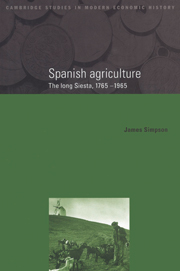Book contents
- Frontmatter
- Contents
- List of illustrations
- List of tables
- Acknowledgements
- Note on the regional division of Spain
- Abbreviations and conventions
- Introduction
- Part I The relative backwardness of Spanish agriculture
- Part II Traditional technologies and market opportunities, 1765–1880
- Part III The limits to technical change, 1880–1936
- 5 Soil fertility and the chemical revolution
- 6 Intensive cultivation and irrigation – a solution to low productivity?
- 7 The reluctance to mechanise
- Part IV Markets and institutions, 1880–1936
- Part V The State and the end of traditional agriculture
- Conclusion
- Appendix Estimates of agricultural output and consumption in nineteenth-century Spain
- Bibliography
- Index
6 - Intensive cultivation and irrigation – a solution to low productivity?
Published online by Cambridge University Press: 04 December 2009
- Frontmatter
- Contents
- List of illustrations
- List of tables
- Acknowledgements
- Note on the regional division of Spain
- Abbreviations and conventions
- Introduction
- Part I The relative backwardness of Spanish agriculture
- Part II Traditional technologies and market opportunities, 1765–1880
- Part III The limits to technical change, 1880–1936
- 5 Soil fertility and the chemical revolution
- 6 Intensive cultivation and irrigation – a solution to low productivity?
- 7 The reluctance to mechanise
- Part IV Markets and institutions, 1880–1936
- Part V The State and the end of traditional agriculture
- Conclusion
- Appendix Estimates of agricultural output and consumption in nineteenth-century Spain
- Bibliography
- Index
Summary
The potential advantage to Spanish farmers of a long growing season (hot summers and mild winters), especially on the Mediterranean coast, is limited by summer drought. From the Roman period, if not before, small irrigation schemes using simple technology and surface water had allowed some farmers to overcome this restriction, producing higher yields and a wider variety of crops. These irrigation systems had been greatly extended during the Muslim occupation and new crops (rice, oranges, mulberries, sugar cane and cotton) introduced. The first section of this chapter shows that the general international interest in the construction of major irrigation schemes at the end of the nineteenth and beginning of the twentieth centuries was shared by many Spaniards, and seen by some as the key to solving the nation's agricultural problems. However, significant problems existed in the extension of irrigation farming. In the remainder of the chapter, I compare the success of an area of traditional irrigation, Valencia, with the difficulties in extending the area of irrigation in a relatively new area, that of the Ebro valley.
Although intensive irrigation cultivation had existed for centuries in Valencia, the half century prior to the Civil War saw farmers not only extending the area, but also introducing high-value crops (especially the orange), and changing production methods (fertilisers, selected seeds, machinery, tube-wells, etc.) in response to changes in factor and product markets.
- Type
- Chapter
- Information
- Spanish AgricultureThe Long Siesta, 1765–1965, pp. 126 - 147Publisher: Cambridge University PressPrint publication year: 1996



